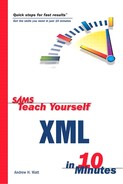Introduction
XML, the Extensible Markup Language, is the basis of many key technologies on the Web and many growing areas of software development. An understanding of at least the basics of XML is essential for an increasing number of Web developers and software developers.
XML bears many similarities to HTML, but it is sufficiently different to cause problems for many newcomers to XML. To write XML code that won’t cause an XML parser to choke, you need to get many things right. Some are simple—for example, XML is case sensitive. Others are more subtle. It’s important that you get on top of these issues right at the beginning of using XML.
This book teaches you how an XML document is correctly formed—”well-formed,” in XML jargon—and how to make use of several of the key XML-related technologies, including XPath, XSLT, the Document Object Model, SAX, and the W3C XML Schema. By the time you finish reading this book, you will understand what these XML-related technologies do and will have grasped many key facts about each of these important technologies so that you can begin to use them for yourself.
Who Is Sams Teach Yourself XML in 10 Minutes For?
This book is for you if
You are new to XML and you want to get a handle on what XML is really about.
You want to quickly learn the key facts about using XML and its important associated technologies.
You want to know how to create well-formed XML.
You want to get a handle on Document Type Definitions (DTDs).
You want to understand how you can create HTML from XML using XSLT.
You want to be able to change the structure of an XML document using XSLT.
You want to learn the basics of programming XML using the Document Object Model and the Simple API for XML (SAX).
You want to understand the basics of how W3C XML Schema works.
What This Book Covers
This book shows you how an XML document is correctly structured. It also explains and demonstrates how to write XML so that it is well-formed and, therefore, acceptable to an XML parser.
XML is full of jargon, so new terms are explained as they are introduced. The book also has a glossary that explains or reminds you of what many terms mean and when they are used.
You’ll be introduced to Document Type Definitions (DTD), which are used to define the allowed structure of a class of XML documents. You’ll also learn about using entities in XML, to allow reuse of XML content.
In addition, the book discusses and demonstrates the use of Cascading Style Sheets (CSS) and Extensible Stylesheet Language Transformations (XSLT). You’ll also be introduced to linking in XML using the XML Linking Language (XLink) and the XML Pointer Language (XPointer).
The book goes on to cover Scalable Vector Graphics (SVG), and it demonstrates programming XML using the Document Object Model and the Simple API for XML. The final chapter of the book introduces W3C XML Schema, a schema technology that goes beyond the capabilities of the DTD.
Of course, a book of this length can’t tell you everything about XML and its associated family of technologies. You’re pointed to sources of further information on XML in Appendix A, “XML Online Resources.”
What You Need to Use This Book
You don’t need expensive tools to create XML code similar to the code you see in this book. If you want, you can use a plain text editor such as Windows Notepad. However, an XML-aware editor such as XML Writer (a 30-day free trial download is available at www.xmlwriter.net) is better.
You will need XSLT software to run some of the code. Three free suitable downloads of XSLT software are listed in Appendix B, “XML Tools.”
To view SVG, you will need an SVG viewer, such as the Adobe SVG Viewer; it can be downloaded free from www.adobe.com/svg/.
To run the code for the DOM and SAX chapters, you will need a JavaScript interpreter (present in almost all Web browsers) and a Java Virtual Machine (already installed on most operating systems).
Source Code and Updates
For updates to this book and to download the source code and examples presented in this book, visit www.samspublishing.com. From the home page, type this book’s ISBN (0672324717) into the search window and click Search to access information about the book and for a direct link to the source code.
